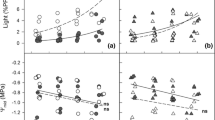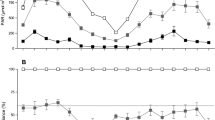Abstract
Few studies have evaluated elevated CO2 responses of trees in variable light despite its prevalence in forest understories and its potential importance for sapling survival. We studied two shade-tolerant species (Acer rubrum, Cornus florida) and two shade-intolerant species (Liquidambar styraciflua, Liriodendron tulipifera) growing in the understory of a Pinus taeda plantation under ambient and ambient+200 ppm CO2 in a free air carbon enrichment (FACE) experiment. Photosynthetic and stomatal responses to artificial changes in light intensity were measured on saplings to determine rates of induction gain under saturating light and induction loss under shade. We expected that growth in elevated CO2 would alter photosynthetic responses to variable light in these understory saplings. The results showed that elevated CO2 caused the expected enhancement in steady-state photosynthesis in both high and low light, but did not affect overall stomatal conductance or rates of induction gain in the four species. Induction loss after relatively short shade periods (<6 min) was slower in trees grown in elevated CO2 than in trees grown in ambient CO2 despite similar decreases in stomatal conductance. As a result leaves grown in elevated CO2 that maintained induction well in shade had higher carbon gain during subsequent light flecks than was expected from steady-state light response measurements. Thus, when frequent sunflecks maintain stomatal conductance and photosynthetic induction during the day, enhancements of long-term carbon gain by elevated CO2 could be underestimated by steady-state photosynthetic measures. With respect to species differences, both a tolerant, A. rubrum, and an intolerant species, L. tulipifera, showed rapid induction gain, but A. rubrum also lost induction rapidly (c. 12 min) in shade. These results, as well as those from independent studies in the literature, show that induction dynamics are not closely related to species shade tolerance. Therefore, it cannot be concluded that shade-tolerant species necessarily induce faster in the variable light conditions common in understories. Although our study is the first to examine dynamic photosynthetic responses to variable light in contrasting species in elevated CO2, studies on ecologically diverse species will be required to establish whether shade-tolerant and -intolerant species show different photosynthetic responses in elevated CO2 during sunflecks. We conclude that elevated CO2 affects dynamic gas exchange most strongly via photosynthetic enhancement during induction as well as in the steady state.
Similar content being viewed by others
Author information
Authors and Affiliations
Additional information
Received: 1 April 1999 / Accepted: 16 August 1999
Rights and permissions
About this article
Cite this article
Naumburg, E., Ellsworth, D. Photosynthetic sunfleck utilization potential of understory saplings growing under elevated CO2 in FACE. Oecologia 122, 163–174 (2000). https://doi.org/10.1007/PL00008844
Issue Date:
DOI: https://doi.org/10.1007/PL00008844




